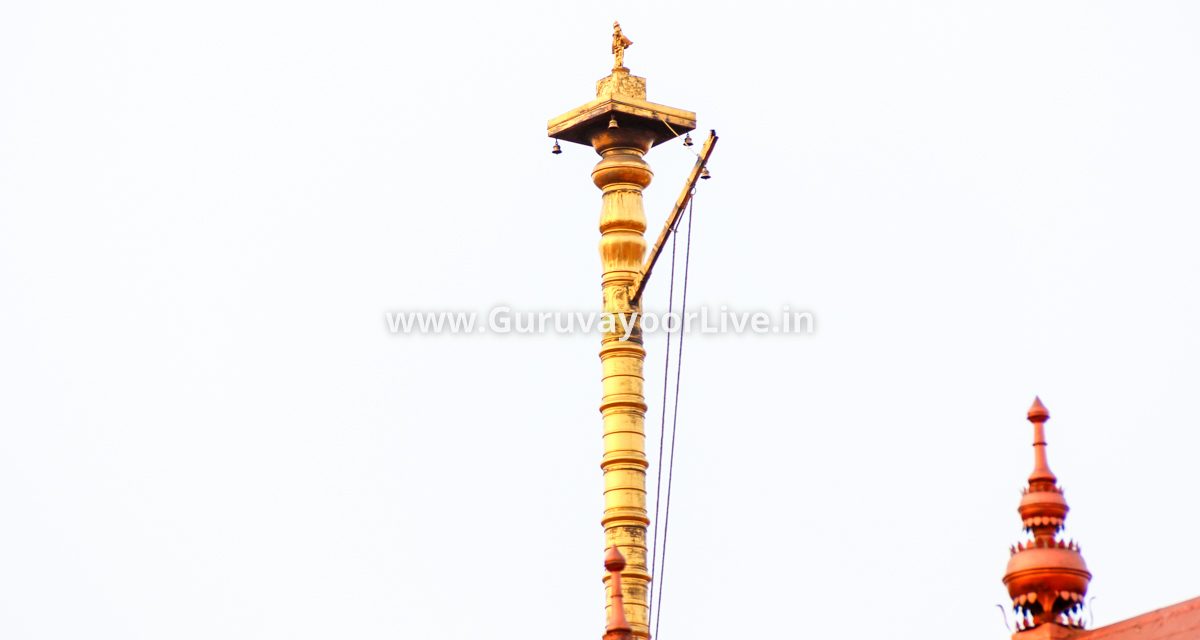

Guruvayur, the Utsavam lasts for ten days. Beginning on the day of Pushya (the 8th asterism) in the month of Kumbham ( February-March), it ends after the Aarattu on the 10th day.
Religiously, it is the restoration of divine Chaithanya. Brahmakalasam is preceded by the Utsavam. It is aimed at the purification and energisation of the powers of the deity. It is the last of the long series of rituals of kalasam and at the end, the flag will be hoisted heralding the Utsavam.
Culturally, it consists of various processions, illumination and modest fire-works (this is a specialty of Guruvayur Utsavam that no explosives are used, unlike most of the other Kerala temples). All ten days, the place wears a festive look, streets dressed up with arches, festoons etc., houses freshly thatched and painted. Every shrine and building is tastefully decorated with lights, plantain trunks, bunches of coconut and arecanuts. Two Gopurams and the bahyankana (outer-courtyard) are elaborately decorated with illuminations and eye-catching electric displays. The lamps, deepasthambams and vilakku are all lightened.
The annual festival at the famed Guruvayur Sree Krishna temple is on. As usual, this year too, the Guruvayur Devaswam has made elaborate arrangements, well in advance, for the ten day long festival. Beginning on the day of Pushya (the 8th Asterism) during the Malayalam month of Kumbham (February-March, as per the English calendar), the festival, perhaps the best known in this part of the world, ends with the much publicised Aarattu on the tenth day.
Religiously, the festival, utsavam in local parlance, is held in reverence in the restoration of divine Chaithanya. And Brahmakalasam is always preceded by the utsavam. It is aimed at the purification and energisation of the powers of the deity. It is the last of the long series of rituals of ’kalasam’ and at the end, the festival flag will be hoisted heralding the utsavam.
Culturally, the annual festival consists of various processions, extravagant illumination and modest fire-works (this is a specialty of the festival at Guruvayur that no explosives are used, unlike most of the other Kerala temples). All throughout the ten days, the entire place wears a festive look, streets get dressed up with decorative arches and festoons and houses get a fresh coat of painting. Every shrine and building is tastefully decorated with lights, plantain trunks, bunches of coconut and arecanuts. Two ’gopurams’ and the ’bahyankana’ (outer-courtyard) are elaborately decorated with illuminations and eye-catching electrical and electronic displays. The lamps, deepasthambam and vilakku are all lightened
The salient features of the festival include an elephants race, custom of sowing seeds, hoisting of the festival flag, pallivetta and aaratt. The festival begins with Aanayottam and every year, the same attracts several thousands of devotees and tourists from across the world. Religiously, the festival begins with the giving of koora (cloth) and pavithram (ring made of Kusa grass) to the tantri. In ancient times, the permission for the festival was taken from Pura koyma, Vanneri Nambidi and Kantiyur Pattar.
Elephant race is followed by sowing of seeds. The custom is called mulayidal in which a number of pots, made of silver are filled with clay and are kept at vathilmatam. The tantri sows various seeds and finally the pots are kept at mulayara. The kodiyettam or hoisting of the flag is performed at night after the mulayidal.
The chaithanya of Garuda is transferred to the flag. The flag and the flagstaff are worshiped by the tantri. Then Puthiyadathu Pisharodi invites complaints from people, Chakkiyar performs Chakkiyar Koothu at the Koothambalam every day after the Ucha- puja. Pallivetta or the royal hunt starts with the Lords arrival at the Samudaya madam (Devaswom Office). By the time Lord arrives, 40 to 50 people wearing masks resembling the boar, called Pannimanushams with their bodies covered with wigs and plantain leaves. Pannimanushams, each await with two helpers who are painted to look like a boar but without mask. After the Pisharodi’s call, pallivatta begins with the Lord on elephant run after the Pannimanushams. They take refuge around temple and at the end of the ninth round pannimanushams are beaten by the Lord.
As the Lord is tired by the Pallivetta, the temple opens only on the next day (10th day) after 6.00 am. The usual rituals are done except usha-puja. There are two utsava-vigrahas, of which one is made of silver and other is of gold.
The former is older and is taken out only during the annual festival. Arattu procession starts at about 6.30 pm and comes out from the Eastern Gopuram . The procession moves along south lane and turns towards Western Gopuram. It goes round Rudratheertham (holy water tank) and comes to Athani (porter’s rest place), set in memory of Kantiyur Pattar. Procession halts for a minute there and silence is observed. Then it comes to Edatharikathu Bhagavaty’s shrine.
Arattu then proceeds to Rudratheertham for abhishekam with tender coconut water which is brought by the Kittai of Thampuran Patikkal. The tantri takes a dip with the silver utsava-vigraha in the Rudratheertham and soon after that thousands of people also take a holy dip in it. Again the utsava-vigraha mounts on elephant and it enters Kizhakke Gopuram and Ottapradikshinam (running circumambulation) takes place. The rounds run are seven on kodiyettam day, nine on the pallivetta and eleven on the Arattu day.
These are the most thrilling episodes of the annual festival at Guruvayur Sree Krishna temple. The elephant runs round the temple eleven times and people follow it with good spirit. After the eleventh round the utsava-vigraha is taken inside. The Pisharodi shouts to invite complaints, if no one comes forward then the flag is held down with which the curtains of the ten-day long festival comes down.









